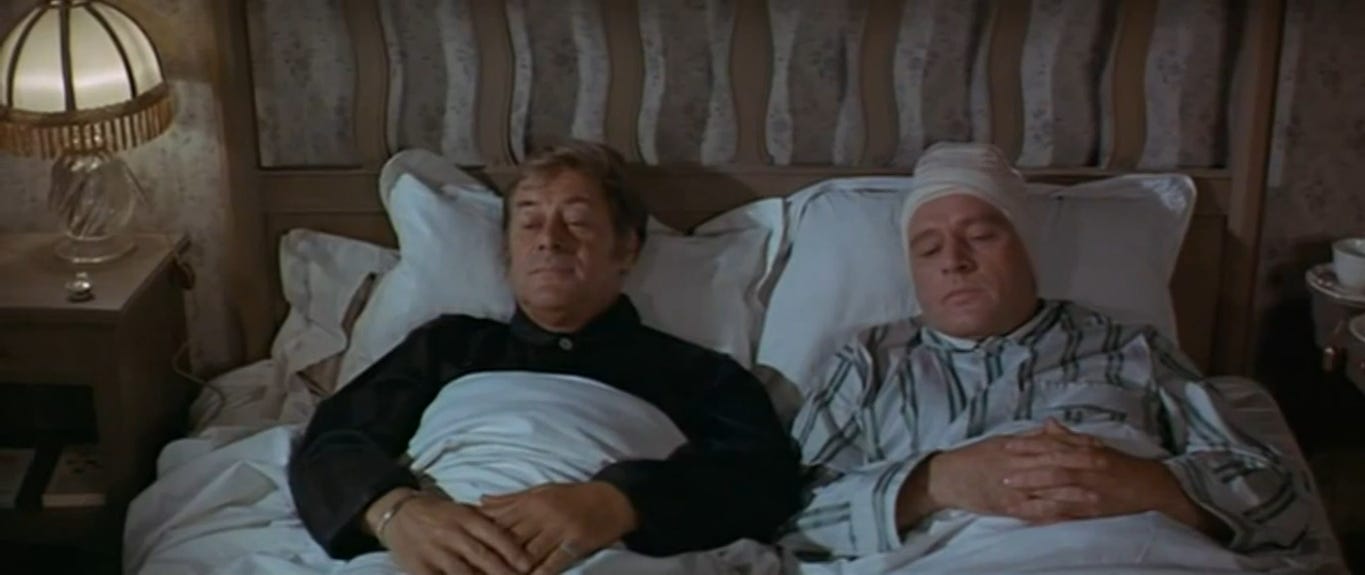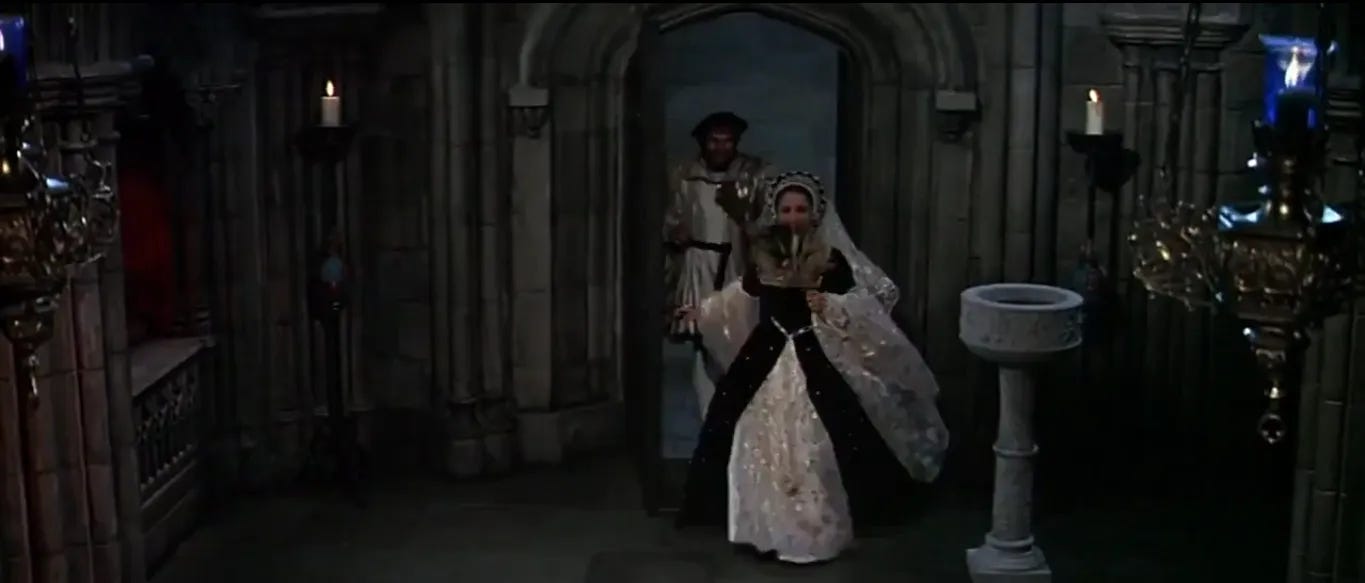There is nothing wrong with your newsletter. Do not attempt to adjust the newsletter. I understand if you’re concerned, though. “Didn’t we already watch a movie where Henry VIII kills all his friends to marry Anne Boleyn,” you’re probably asking. Yes, yes we did. It was called A Man for All Seasons.1 But I guess we’re just gonna do it again.
While A Man for All Seasons focused on Thomas More, Anne of the Thousand Days is about the relationship between Henry (Richard Burton) and Anne (Geneviève Bujold). Henry is unhappy that his marriage to Catherine of Aragon (Irene Papas) has not yielded him a son. When he meets Anne, he’s infatuated with her, but Anne won’t give in to the king: she knows that “what His Majesty is denied, he goes half-mad to obtain; what he gets freely, he despises.”
So to get that which he is denied, Henry merrily hacks his way through church, state, and friends. Yes, we’ve discussed this before. Henry succeeds in divorcing Catherine and marrying Anne, but history repeats itself: now Anne can’t provide Henry a son and Henry’s eye wanders to another woman at his court.
The end: Anne is brought to trial on trumped-up charges of infidelity and incest on the recommendation of Thomas Cromwell (John Colicos). She is executed and Henry rides off into the sunset to get engaged to Jane Seymour.
Rating: 7/10, a movie about a dude who invented a whole new church just to get out of the friend zone.
Cast and Crew
By 1969, Richard Burton was deep in the throes of his relationship with Elizabeth Taylor. Most of the films he made in this period were with her2, including two we’ve watched: Cleopatra and Who’s Afraid of Virginia Woolf? And, though she’s uncredited, Taylor was an extra in Anne of the Thousand Days.3
Two non-Taylor movies from Burton to highlight from this period are Where Eagles Dare (1968), a war picture with Clint Eastwood, and Stanley Donnen’s Staircase (1969), where Burton and Rex Harrison are an old gay couple.4

Geneviève Bujold hasn’t been mentioned on “Jeopardy!” for twenty years, but her portrayal of Anne Boleyn almost makes Henry’s simp behavior seem reasonable. So, what else was she in? Well…a bunch of movies I have only passing familiarity with. Earthquake (1974) with Charlton Heston. Obsession (1976), a Brian De Palma film written by Paul Schrader. Tightrope (1984) with Clint Eastwood. Three films with director Alan Rudolph. Dead Ringers (1988), a David Cronenberg film. We’ll try and catch some of these in future Wrap-Ups.
Quick Hits:
Irene Papas played Catherine of Aragon. We saw her previously in Zorba the Greek, and she’s in another of the 1969 films up for Best Picture (Z) that we’ll discuss during the Wrap-Up.
Anthony Quayle, who we saw in Lawrence of Arabia, plays Thomas Wolsey. He pales in comparison to Orson Welles’ fat, sweaty take on the character from A Man for All Seasons.
Maxwell Anderson wrote the 1948 play “Anne of the Thousand Days.” On Broadway, Rex Harrison and Joyce Redman played the leads; Harrison won a Tony.
The Trivia
Well, we’ve already covered Henry’s wives and his Thomases, so today we’re gonna zoom out and discuss important figures in the Protestant Reformation. The beginning of the Reformation is usually pegged to 1517, when Martin Luther, a priest and professor of moral theology at the University of Wittenberg, published the “95 Theses.”5 But you can’t just start with Luther. That’d be too easy. You gotta start, like, at least 200 years before that…
…with John Wycliffe, an Englishman from the 1300s. Here’s the thing to know about Wycliffe: he was the first person to translate the Bible into English. He argued that scripture was the true center of Christianity, and at a time when access to the Bible was tightly controlled by the church, he worked to make it available to ordinary people. Wycliffe also condemned institutions like the papacy, clergy, and monasteries as corrupt.6 Some of that stuff sounds awfully Reformation-y to me.
Next up: the Czech reformer Jan Hus (1369–1415). Hus was alive during the Western Schism, when there were two popes: one in Rome and another in Avignon, France. Like Wycliffe, Hus had issues with the legitimacy of the church (he was against the sale of indulgences, for one) and believed in greater access to the Bible. The church invited Hus to the Council of Constance to discuss his concerns, but it was a setup: when he got there, they burned him alive.
Hus’ followers, called Hussites, were incensed by the execution of their bud and began actin’ out. This led to a literal crusade being launched against them. Somehow, the Hussites survived and, though they submitted to the rule of the king of Bohemia, they were allowed to practice how they wanted. I’m not gonna pretend I know anything about all this, but it sounds very exciting.
WHEN ARE WE GONNA GET TO MARTIN LUTHER? Well, only after we talk about Desiderius Erasmus of Rotterdam (1466–1536). He was a Humanist7 scholar and Catholic reformer. He criticized church corruption, superstitions, and abuses in works like “The Praise of Folly,” but, unlike Hus and Luther, he opposed breaking from the church. He and Thomas More were pen pals, and More got his nickname when Erasmus called him “omnium horarum homo.”
So…now Luther? Well, we mentioned up top the whole thing with the “95 Theses.” Though many of the ideas in them weren’t new (he talked indulgences, corruption, and salvation from faith alone), they spread because of an invention the proto-Reformationists didn’t have access to: the printing press. Luther’s Theses were a direct attack on the church, so Luther was summoned to the Diet of Worms in 1521 to stand before Emperor Charles V.8 When Luther refused to recant, Charles issued the Edict of Worms, declaring Luther a “notorious heretic.” Luther was excommunicated by Pope Leo X and his works were suppressed.
Nonetheless, Luther kept working: he translated the Bible into German, continuing the push to make scripture more accessible. Also, Luther was a priest but took offense with the whole “celibacy” thing, so in 1525 he married the nun Katharina de Bora. Overall, his work culminated in a new religion: Lutheranism.9 Luther himself couldn’t attend the 1530 Diet of Augsburg with Charles V, so Philipp Melanchthon took the lead on negotiations, including giving the Augsburg Confession.
Darn, I guess we shouldn’t have spent so much time on Wycliffe. Let’s speed through some more Reformation figures:
Huldrych Zwingli (1484–1531) was a Swiss Reformer. He pushed for state control of the church and died in battle during a civil war between Protestant and Catholic Swiss cantons in 1531.
Anabaptists, who believe baptism has to be a conscious decision (meaning it doesn’t work on babies) put together the 1527 Schleitheim Confession, which described their core beliefs. The monk Michael Sattler (1490–1527), who wrote the Confession, was executed.
John Calvin (1509–1564), known as “The Pope of Geneva,” was born in France but is most associated with Geneva (a Protestant Republic), where he was invited to reform the church. The Huguenots were French Protestants influenced by Calvin.
John Knox (1514–1572) was a Scottish reformer who founded the Presbyterian Church (aka the Church of Scotland). He wrote “History of the Reformation in Scotland.”
Note that William Tyndale (1494–1536) is another famous translator of the Bible into English. He fits into our story because he advocated the very Protestant view that the monarch, not the pope, should be in charge of a country’s church. Henry VIII heard that and liked it, but he didn’t like that Tyndale thought Henry should stay married to Catherine of Aragon. Tyndale fled England but was arrested by Charles V and was executed by strangulation. His last words were “Lord, open the King of England’s eyes!” (Spoiler: the Lord did not open the King of England’s eyes.)
And maybe we don’t need to remind you, but real quick: Henry VIII was once named “Defender of the Faith” by Pope Leo X because he wrote “Defense of the Seven Sacraments,” which argued against Martin Luther. The title “Defender of the Faith” became ironic when Henry broke with Rome and founded the Church of England (Anglicanism). Thomas Cranmer, the Archbishop of Canterbury, wrote the Book of Common Prayer, the Anglican liturgical text.
When’d this mess end? Well, it depends. The Peace of Augsburg (1555) recognized Lutheranism in the Holy Roman Empire and established the principle of “cuius regio, eius religio,” where rulers could choose their territories’ religion (as long as they chose either Catholicism or Lutheranism). But you could also say it ended with the Peace of Westphalia (1648), which concluded the Thirty Years’ War and recognized the legitimacy of Calvinism alongside Catholicism and Lutheranism.
Odds and Ends
This was the final of Hal Wallis’ 19 nominations for the Best Picture Oscar…everyone in England was named Thomas in the 1500s…the movie covers the sacking of Rome by Charles V, which is the seventh and final time Rome was sacked…the reference in the first line of this post was to “The Outer Limits” (1963–1965), a show famous mostly for its introduction…Henry calls Anne “Nan,” which is a silly nickname for Anne…director Charles Jarrott wasn’t done making Tudor dramas: his next film was Mary, Queen of Scots (1971)…apparently the film is rife with historical inaccuracies, if that’s something that bothers you.
Though you might also be getting The Lion in Winter vibes, since both films feature an English monarch with a hot mistress trying to discard his wife.
Including The V.I.P.s (1963), The Sandpiper (1965), The Taming of the Shrew (1967), Doctor Faustus (1967), The Comedians (1967), and Boom! (1968).
Apparently Taylor hung around set to keep an eye on Burton and make sure he didn’t have an affair with Geneviève Bujold.
Staircase was a direct influence on the play “La Cage aux Folles,” which was adapted into The Birdcage (1996).
The day celebrated as “Reformation Day” is October 31st, when Luther sent the Theses to the Archbishop of Mainz. The Theses went up on the door of All Saints’ Church sometime after that.
Those inspired by his teachings were known as Lollards; one Lollard, Sir John Oldcastle, led a 1414 uprising. This led to Wycliffe being declared a heretic, though he was already dead at this point. His works were burned and he himself was exhumed and beheaded.
Humanism supported returning to the original sources of Christian teaching. It also supported critical thinking and moral reform.
If you’ll recall, Charles V was Catherine of Aragon’s nephew.
Of note is that Martin Luther was also an anti-Semite. From the AJC: “Hitler was influenced by those who appropriated and re-energized Luther’s anti-Jewish polemics.” Read about that here.





